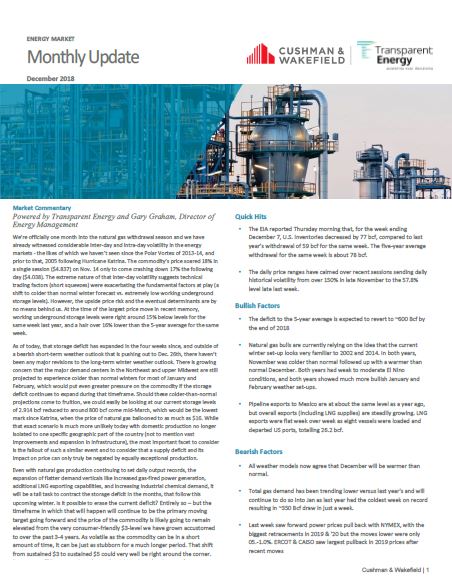 We’re officially one month into the natural gas withdrawal season, and we have already witnessed considerable inter-day and intra-day volatility in the energy markets – the likes of which we haven’t seen since the Polar Vortex of 2013-14 and, prior to that, 2005 following Hurricane Katrina.
We’re officially one month into the natural gas withdrawal season, and we have already witnessed considerable inter-day and intra-day volatility in the energy markets – the likes of which we haven’t seen since the Polar Vortex of 2013-14 and, prior to that, 2005 following Hurricane Katrina.
The commodity’s price soared 18% in a single session ($4.837) on Nov. 14 only to come crashing down 17% the following day ($4.038). The extreme nature of that inter-day volatility suggests technical trading factors (short squeezes) were exacerbating the fundamental factors at play (a shift to colder than normal winter forecast vs. extremely low working underground storage levels).
However, the upside price risk and the eventual determinants are by no means behind us. At the time of the largest price move in recent memory, working underground storage levels were right around 15% below levels for the same week last year, and a hair over 16% lower than the 5-year average for the same week.
- The EIA reported Thursday morning that, for the week ending December 7, U.S. inventories decreased by 77 bcf, compared to last year’s withdrawal of 59 bcf for the same week. The five-year average withdrawal for the same week is about 78 bcf.
- Natural gas bulls are currently relying on the idea that the current winter set-up looks very familiar to 2002 and 2014. In both years, November was colder than normal followed up with a warmer than normal December. Both years had weak to moderate El Nino conditions, and both years showed much more bullish January and February weather set-ups.
- Total gas demand has been trending lower versus last year’s and will continue to do so into January as last year had the coldest week on record resulting in ~350 Bcf draw in just a week.
To learn more about these developments and to get the latest prices, trends, data highlights, and temperature probabilities read the full energy update.
If you have any questions, Gary Graham, our director of energy management, can take you through the report.




